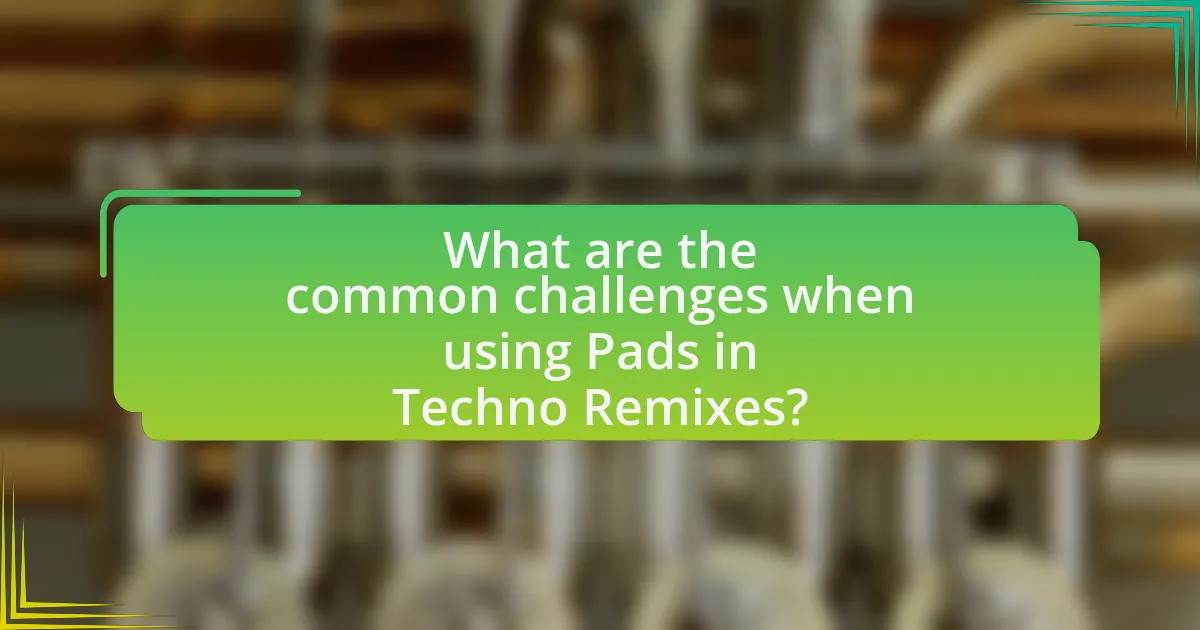The article focuses on the role of pads in techno remixes, highlighting their importance in creating atmospheric soundscapes that enhance emotional depth and texture. It discusses various types of pads, such as atmospheric, lush synth, and evolving pads, and their influence on the mood of a track. The article also addresses techniques for effectively utilizing pads, including layering, modulation, and mixing strategies to maintain clarity and balance with other elements. Additionally, it explores common challenges producers face when incorporating pads and offers practical tips for achieving a cohesive and engaging sound in techno music.

What are Pads in Techno Remixes?
Pads in techno remixes are sustained, atmospheric sounds that create a sense of space and depth within a track. These sounds often utilize synthesizers to produce rich, harmonic textures that enhance the overall mood of the music. In techno, pads serve to fill out the sonic landscape, providing a backdrop against which other elements like beats and basslines can stand out. Their use is crucial for building tension and emotional resonance, often characterized by slow attack and release times, which contribute to a smooth, flowing sound.
How do Pads contribute to the overall atmosphere in Techno music?
Pads contribute to the overall atmosphere in Techno music by creating lush, ambient soundscapes that enhance emotional depth and texture. These synthesized sounds often fill the sonic space, providing a sense of warmth and continuity that supports rhythmic elements. For instance, pads can evoke feelings of euphoria or introspection, which are essential in maintaining the immersive experience characteristic of Techno. Their sustained tones and evolving harmonies help to build tension and release, crucial for engaging listeners during extended tracks. This atmospheric role is supported by the use of reverb and modulation effects, which further enrich the sound and create a three-dimensional auditory experience.
What types of Pads are commonly used in Techno remixes?
Commonly used pads in Techno remixes include atmospheric pads, lush synth pads, and evolving pads. Atmospheric pads create a sense of space and depth, often utilizing reverb and delay effects to enhance the immersive experience. Lush synth pads provide rich harmonic content, typically characterized by wide stereo imaging and warm tones, which contribute to the overall emotional impact of the track. Evolving pads, on the other hand, change over time, often incorporating modulation techniques to maintain listener interest and drive the track forward. These types of pads are essential for building the atmospheric qualities that define Techno music.
How do different Pad sounds influence the mood of a track?
Different pad sounds significantly influence the mood of a track by creating emotional depth and atmosphere. For instance, lush, warm pads often evoke feelings of comfort and nostalgia, while sharp, bright pads can generate excitement or tension. Research indicates that specific frequencies and timbres in pad sounds can elicit distinct emotional responses; for example, lower frequencies are associated with calmness, while higher frequencies can induce feelings of happiness or anxiety. This relationship between sound characteristics and emotional perception is supported by studies in music psychology, which show that listeners often associate certain sonic qualities with specific moods, thereby shaping their overall experience of the track.
Why are Pads essential for building atmosphere in Techno remixes?
Pads are essential for building atmosphere in Techno remixes because they create a lush, immersive soundscape that enhances the emotional depth of the track. The sustained tones and harmonics of pads fill the sonic space, providing a backdrop that complements rhythmic elements and leads. This atmospheric quality is crucial in Techno, where the genre often relies on minimalistic structures; pads help to maintain listener engagement by adding texture and warmth. Research indicates that soundscapes with rich harmonic content can evoke emotional responses, making pads a vital tool for producers aiming to create a captivating auditory experience.
What role do Pads play in creating depth and space in a mix?
Pads play a crucial role in creating depth and space in a mix by providing a lush, ambient backdrop that enhances the overall sonic landscape. These sustained sounds fill frequency gaps and add harmonic richness, which helps to establish a three-dimensional feel in the music. By utilizing reverb and delay effects on pads, producers can further manipulate the perception of distance and space, making elements in the mix feel closer or farther away. This technique is particularly effective in techno remixes, where the atmospheric quality of pads can evoke emotional responses and maintain listener engagement throughout the track.
How do Pads interact with other elements in a Techno remix?
Pads in a Techno remix primarily interact with other elements by creating a lush atmospheric backdrop that complements rhythmic components. They serve to fill sonic space, enhancing the emotional depth of the track while allowing percussive elements, such as kick drums and hi-hats, to maintain their clarity and punch. The use of reverb and modulation effects on pads can further blend them with basslines and synth leads, creating a cohesive soundscape that supports the driving energy typical of Techno music. This interaction is crucial, as it helps establish a sense of movement and progression, which is essential in maintaining listener engagement throughout the remix.

How can Pads be effectively utilized in Techno Remixes?
Pads can be effectively utilized in techno remixes by creating lush, atmospheric soundscapes that enhance the overall mood of the track. These synthesized or sampled sounds can fill sonic space, providing a sense of depth and continuity, which is essential in the repetitive structure of techno music. For instance, using long, sustained pad sounds can help to build tension and release, crucial elements in maintaining listener engagement during extended mixes. Additionally, layering pads with varying textures and modulations can introduce dynamic shifts, keeping the arrangement interesting. This technique is supported by the fact that many successful techno tracks utilize pads to evoke emotions and transport listeners, as seen in works by artists like Richie Hawtin and Carl Craig, who often incorporate atmospheric elements to enrich their sound.
What techniques can be used to layer Pads in a remix?
To layer pads in a remix, techniques such as frequency layering, stereo widening, and modulation can be effectively utilized. Frequency layering involves stacking multiple pad sounds at different frequency ranges to create a fuller sound, ensuring that each layer occupies its own sonic space. Stereo widening enhances the perceived width of the pads by using effects like chorus or delay, which can make the mix feel more expansive. Modulation techniques, such as applying LFOs to parameters like filter cutoff or volume, can add movement and depth to the pads, making them more dynamic and engaging. These methods are commonly employed in electronic music production to enhance the atmospheric quality of tracks.
How does layering different Pad sounds enhance the atmosphere?
Layering different Pad sounds enhances the atmosphere by creating a rich, textured soundscape that evokes emotional depth and complexity. This technique allows producers to blend various tonal qualities, such as warmth, brightness, and depth, which can transform a simple melody into an immersive experience. For instance, combining a lush, wide Pad with a sharper, more defined Pad can create contrast, making the overall sound more engaging and dynamic. Research in sound design indicates that layering can increase perceived richness and fullness, which is essential in genres like techno where atmosphere plays a crucial role in listener engagement.
What are the best practices for mixing Pads with other instruments?
The best practices for mixing pads with other instruments include ensuring proper frequency balance, utilizing stereo width, and applying appropriate effects. Frequency balance is crucial; pads often occupy mid to low frequencies, so cutting unnecessary low-end frequencies from pads can prevent muddiness. This allows other instruments, like bass and kick drums, to have more clarity and impact.
Utilizing stereo width enhances the spatial quality of the mix; placing pads in a wider stereo field can create a sense of depth, making the mix feel more immersive. Panning pads slightly left or right while keeping bass elements centered can achieve this effect.
Applying effects such as reverb and delay can further enhance the atmospheric quality of pads. However, it is essential to use these effects judiciously to avoid overwhelming the mix. For instance, a subtle reverb can add depth without losing the clarity of other instruments.
These practices are supported by mixing techniques commonly used in electronic music production, where clarity and atmosphere are paramount for creating engaging tracks.
How can modulation enhance the use of Pads in Techno remixes?
Modulation enhances the use of pads in Techno remixes by introducing dynamic movement and evolving textures, which create a more immersive listening experience. By applying techniques such as frequency modulation, amplitude modulation, or filter modulation, producers can alter the tonal characteristics and spatial qualities of the pads, making them more engaging. For instance, using LFOs (Low-Frequency Oscillators) to modulate the filter cutoff can produce sweeping effects that add depth and interest to the sound. This approach is supported by the fact that many successful Techno tracks utilize modulation to maintain listener engagement over extended periods, as evidenced by the production techniques of renowned artists like Richie Hawtin and Carl Craig, who frequently employ modulation to enhance their pad sounds.
What modulation effects are most effective for Pads?
Chorus and reverb are the most effective modulation effects for pads. Chorus adds depth and richness by creating multiple slightly detuned copies of the original sound, which enhances the lushness typical of pad sounds. Reverb contributes to the atmospheric quality by simulating space, making the pads feel expansive and immersive. These effects are widely used in electronic music production, particularly in techno, to create a sense of movement and emotional resonance within the mix.
How does modulation impact the listener’s experience?
Modulation significantly enhances the listener’s experience by creating dynamic shifts in sound that evoke emotional responses. In the context of techno remixes, modulation techniques such as frequency modulation, amplitude modulation, and filter modulation introduce variations that keep the listener engaged and maintain interest throughout the track. Research indicates that these changes can influence mood and energy levels, as evidenced by studies showing that listeners respond more positively to music with varied modulation compared to static sounds. This engagement is crucial in genres like techno, where atmosphere and emotional depth are essential for immersive experiences.

What are the common challenges when using Pads in Techno Remixes?
Common challenges when using pads in techno remixes include achieving the right balance in frequency, maintaining clarity in the mix, and ensuring emotional impact without overwhelming other elements. Frequency balance is crucial because pads can occupy similar sonic space as basslines and kick drums, leading to muddiness if not managed properly. Clarity is often compromised when pads are overly lush or dense, which can obscure rhythmic elements essential to techno. Additionally, while pads are intended to evoke emotion, they can become too dominant, detracting from the driving energy characteristic of techno music. These challenges necessitate careful sound selection, EQ adjustments, and dynamic processing to create a cohesive and engaging remix.
What issues might arise when mixing Pads with basslines?
Mixing pads with basslines can lead to issues such as frequency masking, where the low frequencies of the bassline obscure the harmonic content of the pads. This occurs because both elements often occupy similar frequency ranges, particularly in the lower midrange, which can result in a lack of clarity in the mix. Additionally, the sustain and reverb of pads can create a muddy sound when combined with the punchy nature of basslines, making it difficult to achieve a balanced mix. Proper EQing and careful arrangement are essential to mitigate these problems, ensuring that both elements can coexist without compromising the overall sound quality.
How can frequency masking be avoided when using Pads?
Frequency masking can be avoided when using pads by ensuring that the frequency ranges of different elements in a mix do not overlap significantly. This can be achieved through techniques such as equalization, where specific frequencies of the pads are cut or boosted to create space for other instruments. For instance, reducing low frequencies in pad sounds can prevent them from masking bass elements, while carving out mid-range frequencies can help vocals or lead instruments stand out. Additionally, using stereo imaging techniques can enhance the perceived separation of sounds, further reducing the likelihood of frequency masking. These methods are supported by audio mixing principles that emphasize clarity and separation in sound design.
What strategies can be employed to maintain clarity in a mix?
To maintain clarity in a mix, utilize techniques such as frequency separation, panning, and dynamic range management. Frequency separation involves assigning specific frequency ranges to different elements, ensuring that each sound occupies its own space in the mix, which prevents muddiness. Panning helps to create a stereo image, allowing sounds to be positioned in a way that enhances clarity and separation. Dynamic range management, through compression and limiting, ensures that no single element overwhelms others, preserving the overall balance and intelligibility of the mix. These strategies are essential for achieving a clean and professional sound in techno remixes, where atmospheric pads must coexist with other elements without losing definition.
How can producers troubleshoot common Pad-related issues?
Producers can troubleshoot common Pad-related issues by systematically checking for sound quality, volume levels, and effects settings. First, they should ensure that the pad sound is not overly muddy by adjusting the EQ settings to cut unnecessary low frequencies, which can clarify the mix. Next, they should verify that the volume levels of the pads are balanced with other elements in the track to prevent them from overpowering or being too quiet. Additionally, producers can experiment with reverb and delay effects to enhance the spatial quality of the pads, ensuring they fit well within the overall atmosphere of the remix. By addressing these specific areas, producers can effectively resolve common pad-related issues and improve the overall sound of their techno remixes.
What are the signs of overusing Pads in a remix?
The signs of overusing pads in a remix include a lack of dynamic range, muddiness in the mix, and listener fatigue. When pads dominate the frequency spectrum, they can obscure other elements, leading to a flat sound. This is often characterized by excessive reverb or delay, which can create a washed-out effect. Additionally, if the pads are present in every section without variation, they can make the track feel monotonous and reduce emotional impact. These signs indicate that the pads may be overwhelming the overall composition, detracting from the intended atmosphere of the remix.
How can one effectively balance Pads with other elements in a track?
To effectively balance pads with other elements in a track, one should focus on frequency separation and dynamic range management. Frequency separation involves ensuring that pads occupy a distinct frequency range, allowing other elements like bass and percussion to be clearly heard without interference. For instance, using EQ to cut low frequencies from pads can prevent muddiness and create space for the bass. Dynamic range management, through techniques like compression, helps maintain the pads’ presence without overpowering other elements. This approach is supported by the principle that a well-balanced mix allows each element to contribute to the overall atmosphere without clashing, which is crucial in genres like techno where clarity and depth are essential.
What are some practical tips for using Pads in Techno Remixes?
To effectively use pads in techno remixes, focus on creating a lush, atmospheric sound that complements the driving beats typical of the genre. Start by selecting pads with rich harmonic content, such as those that utilize saw waves or granular synthesis, to provide depth. Layer multiple pad sounds to enhance texture, ensuring they are panned across the stereo field for a wider soundstage. Utilize modulation techniques, like LFOs on filter cutoff or amplitude, to introduce movement and variation over time, which keeps the listener engaged. Additionally, applying reverb and delay can further enhance the spatial qualities of the pads, making them feel more immersive. These techniques are supported by the fact that atmospheric elements are crucial in techno, as they help build tension and release, essential for maintaining energy in a track.


